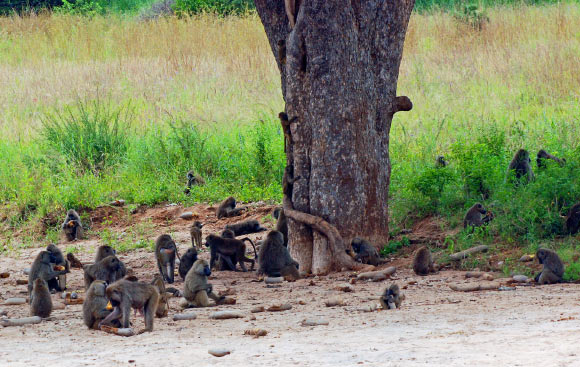According to a new study published online in the journal Science, troops of Olive baboons (Papio anubis) decide where to move democratically.
Until now, scientists had wondered if animals with clear hierarchies use democracy to reach a consensus, or if their decisions are governed by dominant leaders.
It’s been difficult to study this, however, because recording the behavior of many individuals simultaneously has been a challenge.
In a new study, scientists led by Dr Ariana Strandburg-Peshkin of Princeton University leveraged recent advances in GPS technology to track the movements of baboons.
The scientists fitted 25 members of a troop of Olive baboons (also known as Anubis baboons) at the Mpala Research Center in Kenya with GPS collars that recorded each individual’s location once per second for two weeks.
Their data identify certain baboons as initiators – animals that start moving away from other baboons and either ‘pull’ followers with them or ‘anchor’ those individuals in place until the initiator wanders back.
Dr Strandburg-Peshkin and her colleagues found that baboons are generally more likely to follow others when multiple individuals act as initiators and agree on a particular direction. However, when initiators’ opinions are split over where to go, decisions get delayed.
Olive baboons typically don’t attempt to negotiate, instead choosing one direction over the other, if the angle between the options is larger than 90 degrees, but the animals do attempt to compromise if two initiators suggest different directions with less than 90 degrees difference between them.
This suggests that baboons use similar movement rules to many other animals, such as fish and birds.
“It seems that, despite their complex social structure, when it comes to disagreements over where to move it’s a case of ‘one baboon, one vote’ as decision-making is largely a shared, ‘democratic’ process,” said co-author Dr Damien Farine of Oxford University and the Smithsonian Tropical Research Institute.
“Patterns of collective movement in baboons are remarkably similar to models that can predict the movements of fish, birds, and insects, which use a simple set of rules such as follow your neighbor.”
Dr Margaret Crofoot, a senior author on the study and a researcher at the University of California, Davis, and the Smithsonian Tropical Research Institute, added: “we are looking at are very broad patterns here. The next step will be to look at context to figure out what motivates individual baboons to initiate movement in the first place, and if some individuals can take advantage of certain situations to disproportionately influence the group.”
Understanding how groups that exist in such hierarchies reach consensus is critical to understanding the evolution of other socially complex species.
_____
Ariana Strandburg-Peshkin et al. 2015. Shared decision-making drives collective movement in wild baboons. Science, vol. 348, no. 6241, pp. 1358-1361; doi: 10.1126/science.aaa5099








